| MEDIEVAL MUSIC
��1�V��-1 |
| ��396�`414 �b�g�`�o�s�d�q �@�w�Z-1 Guillaume de Machaut http://machaut.weebly.com/machauts-manuscripts.html �̎� �@Important as Philippe de Vitry was in establishing both the mensural principles of the Ars Nova and the structural principles of the isorhythmic motet, he still stands in the shadow of his somewhat yonger and considerably more prolific contemporary Guillaume de Machaut. �@Philippe de Vitry�� Ars Nova�̌v�ʋL���̌����ƃC�\���Y�����e�b�g�̍\�������̑o�����m�������d�v���͂��邪�A�ނ͎�������Ⴍ�A�͂邩�ɑ���ł�����������l��Guillaume de Machaut�̉e�ɉB��Ă��܂��B In large part,the relativepositions of the two men must be the result of their personal interests and preferences. To some degree, however those positions reflect the superficially similar, but in reality profoundly different, circumstances of their lives. It will be useful, therefore, to review those circumstances before we examine the music of the greatest French poet and composer in the fourteenth century. �@Both men came from the province of Champagne, where Philipp was born-presumably in one of six villages named Vitry-on Octob 31, 1291, according to his own account. The date of Machaut's birth is generally believed to have been around 1300. Almost nothing is known about the childhood and early youth of either man. Documented evidence of Vitry's life begins with his appointment as a canon of the Church in 1323 and his service to the French kings from the time of Charles IV (322-28) until 1351. As a responsible and trusted official of the royal household, Vitry twice went on diplomatic missions to the papal court in Avignon, where he became a friend of Petrarch. Two letters from the Italian poet to Philippe praise him as a musician, poet, and man of spirit. In 1351, probably in recognition of his services both to the French kings and to the papacy, as well as for his other merits, Philippe was appointed Bishop of Meaux by Clement VI 366). This high position Philippe held until his death on June 9, 1361 How much of Philippe de Vitry's poetry and music has been lost we do not know, nor can we be sure to what extent his contemporary reputation rested on his position and personal qualities.Certainly the motets attributable to him do not belie that reputation, but it is strange indeed that more did not survive from the creative output of a man so important and so esteemed. It is also strange that more than half of the motets as well as the theoretical treatise must have been completed by the time Philippe was about thirty years of age. That poetry and music did not occupay a primary place in Philippe's concerns during the last forty years of his life seems an inescapable conclusion. With Guillaume de Machaut situation is quite different. He too appears in historical document in the service of a king - John, Count of Luxembourg and King of Bohemia-and ends his life in the Church, but in the less exalted position of canon at Reims Cathedral. Apart from similarities, the activities and interests of the two men seem scarcely to correspond at all. Throughout his life, Machaut remained a practising musician, a and a composer, a prolific poet who supervised preparation of several manuscript collections of his works. Documentary evidence of Machaut's existence dates from a series of papal bulls of 1300 that identify as a "clerk, secretary,and familiar" (i.e,in the household) of John of Bohemia. At the request of King John, these bulls granted Machaut various church benefices and canonicates with the expectation of a prebend when a vacancy occurred. By this common medieval practice, popes sought to gain the loyalty and support of powerful noblemen who, in turn, found it a convenient means of providing supplemental income and future social security for their proteges. In one of the most important bulls, Pope Benedict12 made Machaut a canon of Reims -still in expectation -and allowed him to retain a canonicate at St. Quentin and a chaplaincy in the diocese of Arras. This bull also states that Machaut had been in John of Bohemia's household for about twelve years and thus establishes 1323 as the approximate date of Machaut's entry into the king's service. That service continued for some time after the vacancy of a prebend led to Machaut's installation by procuration (in absentia) as a canon of Reims late in Jan uary, 1337. Being in the service of the king, Machaut was not required to live in Reims, but he seems to have established a residence in that city by 1340. From then until John's death in 1346, Machaut probably re mained on call and may sometimes have rejoined the king for short in- tervals. The duties and restrictions imposed on the seventy-two canons of Reims were far from onerous, although around 1350 they were forbidden to wear long hair. Their primary function was to sing in the Offices, and each canon was also expected to sing for a minimum number of Masses during the course of a year. For fulfilling these duties they received a regular stipend plus a fee for each service in which they took part.In addition, their prebends provided daily or periodic distributions of bread, wine, vegetables, and wood. The canons did not have to be ordained priests, and Machaut seems never to have been than a tonsured clerk. he did not live in the but had his own where he was later joined by his brother Jean of house, wit John Machaut, who also became a canon at Reims after serving times, but Bohemia. In theory, canons were to be in residence all him to be Machaut's position as secretary John of Bohemia permitted absent at the king's pleasure and perhaps also at his own. After the king's death, connections with other members of the highest still gave Machaut freedom to travel, a freedom of which did not fail to take advantage. �@The exact nature of Machaut's relationships with his later patrons remains somewhat conjectural. Most of our information comes from Machaut's poems rather than from official records and often fails to describe the way in which he "served" these patrons. Nevertheless, we know that Machaut was first associated with Bonne of Luxembourg, John of Bohemia's daughter, who married the son of Philippe VI, King of France. After Bonne's death in 1349, Machaut found a new Maecenas in the person of Charles, King of Navarre and pretender to the French throne, who came to be known in history as Charles the Bad. Machaut was apparently not involved in Charles's intrigues and conspiracies with the English against the French royal house. Instead, the poet remained on good terms with both particles and later served King Charles V of King France (1364-80) as well as his brother John, Duke of Berry. In addition to revealing much about Machaut's associations with his royal patrons, his poetry gives many details about himself and the life he led in Reims. We learn, for example ,of his infirmities-gout and blindness in one eye; of his personal experiences in more universal afflictions such as the great plague, the Black Death that ravaged Europe in 1348-49; and of the hardships that resulted from the English invasions and siege of Reims in the early part of the Hundred Years' War (1337-1453). �@In a happier vein, Machaut's poetry reveals his enthusiasm for falconry, his delight in horseback riding, and his pleasure in the beauties of the French countryside. Somewhat surprisingly, Machaut tells next to nothing about his activities in connection with the Church. We can only conclude that those activities occupied but little of either his time or his thoughts. Instead, as the most celebrated poet and composer in France, Machaut led a rather worldly life. Almost without interruption throughout his career, he enjoyed the confidence and patronage of kings and shared their pleasures. THE COMPLETE WORKS One of the most complete and reliable of the Machaut manuscripts begins with an inscription that reads in translation "Here is the order that G. de Machaut wishes to have in his book." A listing of Machaut's works as they appear in this manuscript will therefore reveal both the scope of his creative activity as he wished it to be presented and the place of music in his total output(Table 14�j�D Of Machaut's pieces that have preserved, only five are missing in this manuscript. Presumably,they are his last musical compositions. With some exceptions, the other Machaut manuscripts arrange his works in much the same order and for this reason are thought to have been prepared under his direct or indirect supervision�D �}�V���[�̎ʖ{�̂��������Ƃ����S�ŐM�����̂�����̂̂ЂƂ́A"Here is the order that G. de Machaut wishes to have in his book."�Ƃ����L�q�Ŏn�܂���̂ł���B����䂦���̎ʖ{�ɂ�����}�V���[�̍�i�̃��X�g���́A�ނ��������Ǝv���Ă����ނ̑n�슈���͈̔͂Ɣނ̑���i���ɂ����鉹�y�̒n�ʂ̗����𖾂炩�ɂ��Ă���i�\14�j�BMachaut�̍�i�̂����A�T��i�݂̂����̎ʖ{�ɂ͌����Ă���B�����炭�A�����͔ނ̍Ō�̊y�Ȃł���B �������̗�O�������āA���̃}�V���[�̎ʖ{�́A�ނ̍�i���قړ��������Ő������Ă���A���̗��R����ނ̒��ړI�܂��͊ԐړI�Ȋē̉��ŏ�������Ă���ƍl�����Ă���B p400 Table 14: Machaut's works in the order They Appear in Paris, Bibl. Nat., f.fr 1584 Poetry 1 Prologue (1371?) on 4 of 6 unnumbered leaves added at beginning 2. Le Dit du Vergier (before 1346) fol, 1 3. Le jugement du Roi de Behaigre fol.9v. 4. Le jugement du Roi de Navarre (1349) fol. 22v. 5. Remede de Fortune (1342-49?) fol, 49v 6. Dit du Lyon (1342)�@�@�@�@�@�@�@�@�@�@ fol, 80v 7. Dit de l'Alerion (before 1349) �@�@�@fol. 96v 8. Confort d'Ami (1357) (c. 1361)�@�@ fol, 127 9. Dit de la Fonteinne Amoureuse fol. 154 10. Dit de la Harpe �@�@�@�@�@�@�@�@�@�@�@fol. 174 11. La Louange des Dames (268 lyric poems) fol. 177 v. 12. Dit de la Marguerite fol. 213v 13. Les Complaintes (8 texts) fol. 214v 14, Livre du Voir Dit (c. 1365) fol. 221 15. La Prise d'Alexandrie (not before 1369) fol. 309 16. Dit de la Rose fol, 365v 17. Les biens que ma dame me fait �@�@fol, 366 Musical compositions 18. Lais (22-6 without music, Nos. 17 and 18 missing fol. 367 19, Motets (23)�@�@�@�@�@�@�@�@�@�@�@�@�@�@�@�@�@�@�@�@�@fol. 414v 20. The Mass �@�@�@�@�@�@�@�@�@�@�@�@�@�@�@�@�@�@�@�@�@�@fol. 438v 21. Hocket David �@�@�@�@�@�@�@�@�@�@�@�@�@�@�@�@�@�@�@fol. 451v 22 Balldes(38;Nos.39 and 40 missing)�@�@�@�@�@�@fol. 454 23. Rondeaux (19 Nos. 16 and 21 missing)�@�@�@fol. 475 24. Virelais (38-6 without music �@�@�@�@�@�@�@�@�@ fol. 482-94 �@In compiling his collected works, Machaut appears to have arranged his longer poems in approximately chronological order except for the Prologue, the final version of which, fittingly enough, was written last. He then completed the collection with his musical works grouped according to formal types. It is generally assumed that within each type the pieces again appear in more or less chronological order, and comparative studies of the different manuscripts confirm this view to some extent. �@�ނ̎��g�̍�i��ҏW����ɂ�����AMachaut�́A�v�����[�O�������āA�قڔN�㏇�ɂ�蒷��������ׂ��悤�Ɍ����邪�A�ŏI�ł͍Ō�ɏ����ꂽ���̂ł������B �ނ͂��̌�A�����Ɋ�Â��ăO���[�v�����ꂽ���y��i�ŃR���N�V�����������������B ��ʓI�ɂ́A���ꂼ��̗l���̒��ŁA��i�͂قڎ��n��I�ɏo�����Ă��邪�A�قȂ�ʖ{�̔�r�����ɂ���Ă��̌�����������x�m�F����Ă���ƈ�ʓI�ɐ�������Ă���B At any rate, the more complete Machaut manuscripts generally repeat the series of pieces in the different groups before adding new an presumably later compositions to each group. Further information as to the chronology of Machout's music is extrapolated from stylistic considerations and the relationships between musical compositions and datable poems. ������ɂ��Ă��A��芮�S��Machaut�ʖ{�́A��ʓI�Ɋe�O���[�v�ɐV������Ȃ�lj�����O�ɁA�قȂ�O���[�v�̈�A�̍�i���J��Ԃ��Ă���BMachaut�̉��y�̎��n��Ɋւ��邳��ɏڂ������́A�l���I�l�@��A��ȂƔN��̓���ł��鎍�̊W�Ȃǂ���O�}����Ă���B p401 Yet even when all these factors are taken into account, the results are somewhat disappointing�D Only a relatively small number of pieces can be dated with any precision. For the rest, any assigned dates remain conjectural and must allow for a wide margin of error. is not very helpful, for example, to suspect that the first sixteen ballades were written before 1349, when Machaut was nearly fifty. �������A�����̗v�������ׂčl������Ă��A���ʂ͂����炩���]�ƂȂ�B��r�I���Ȃ���i�ł����A���m�ɍ�Ȃ̓��t���킩����̂͏��Ȃ��B�c��̏ꍇ�A���蓖�Ă�ꂽ���t�͗ސ��̂܂܂ł���A�덷�̍L���}�[�W�������e����K�v������B���Ƃ��ŏ���16�̃o���[�h���AMachaut��50�߂���1349�N�O�ɏ����ꂽ�ƍl����ƁA���܂�L�p�ł͂Ȃ��B Linking stylistic development with precisely dated works adds something to our edge of chronology, but the results must always be accepted with great caution. New stylistic features in a dated composition necessarily mean that they were first used in that piece or that all subsequent pieces abandon older procedures. ���m�ɓ��t�̂킩���Ă����i���l���̔��B�������т��邱�Ƃ́A���n��̐�[�ɉ����������邱�Ƃł��邪�A���ʂ͏�ɁA���ɐT�d�Ɏ���Ȃ���Ȃ�Ȃ��B���t�̂킩���Ă����i�̐V�����l���̓����́A�K�R�I�ɁA����炪���̍�i�Ŏg�p���ꂽ���ƁA�܂��͌㑱�̂��ׂĂ̍�i���A�Â��菇��������邱�Ƃ��Ӗ�����B Because of differing styles in the different musical types, moreover, determining dates and chronology for one type yields little or no information about the others. Interesting and important as they are, questions of chronology can therefore be dealt with only incidentally in discussing the different types of Machaut musical compositions. ����ɁA�قȂ鉹�y�^�C�v�̗l�����قȂ邽�߁A����^�C�v�̓��t�ƔN�㏇�����肷��ƁA���̃^�C�v�Ɋւ����قƂ�Ǔ����Ȃ��B����炪�������������Ă���Ɠ����ɏd�v�Ȃ��̂ł��邽�߁A���n���̋^��́A�قȂ�^�C�v��Machaut�̊y�Ȃ��c�_���邱�Ƃ����ŁA���R�I�Ɉ������Ƃ��ł���B Before doing so, however, we must mention several the poetic works that in one way or another are particularly related to music.�@Written about 1371, the Prologue in its complete form was apparently Machaut's last important poem. In 184 lines and four ballades, the poet sets forth his artistic principles and, despite the absence of music for the ballades, lays more stress on music's importance than in any other work except the Remede de Fortune. ���������̑O�ɁA���炩�̌`�ʼn��y�ɓ��ɊW���Ă��邢�����̎��I�ȍ�i�ɂ��ďq�ׂȂ���Ȃ�Ȃ��B��1371�N�ɏ����ꂽ�A���̊��S�Ȍ`���̃v�����[�O��,���炩�ɁAMachaut�̍Ō�̏d�v�Ȏ��ł������B 184�s��4�̃o���[�h�ł́A���l�͌|�p�I�������߂Ă���A�o���[�h�̂��߂̉��y�����@���Ă���ɂ�������炸�ARemede de Fortune(�^���̖���j���������̍�i�������y�̏d�v���ɏd�_��u���Ă���B The latter is a typical medieval treatise on Love and Fortune that Machaut enlivened by framing it in a realistic narrative of a personal love affairs. This narrative provided an opportunity for the introduction of songs, but true to his didactic purpose, Machaut illustrated the style, poetic construction, and musical setting of seven different lyric forms. Four of the songs are monophonic�F a lai, a virelai, and the less common forms of complainte and chanson royal (see below). The three polyphonic pieces illustrate the rondeau and two forms of the ballade. ���Remede de Fortune(�^���̖���j�́A���ƍK�^�ɂ��Ă̓T�^�I�Ȓ����̘_���ł���AMachaut�͂���������I�ȗ����̕���ō\�����邱�Ƃɂ���Ċ��C�Â����B���̕���͉̂̓����̋@���^�������A�ނ̌[�֓I�ړI�ɂƂ��ẮA�^���ł���AMachaut�͗l���A���̍\���A������7�̈قȂ�������`�������y�ݒ���������B�̂̂����S�Ȃ̓��m�t�H�j�b�N�ł���B������lai�ł���Avirelai�ł���A���܂��ʓI�łȂ�complainte and chanson royal�`���ł���B�c���3�̃|���t�H�j�b�[��i�́A�����h�[�ƃo���[�h�̂Q�`���������Ă���B The date of Remede Fortune has much discussed,but there now seems to be general agreement that it must have been completed before 1349, possibly even by 1342. At any rate, the poem stands among Machaut's first major works, and the illustrative pieces must be among his ealier composition. That Machaut regarded music as an esential part of the Remede de Fortune is indicated by the fact that all manuscripts place the pieces within the poem rather than at the end with the other musical works. Remede Fortune�̊����̓��t�͋c�_���������A1349�N���O�ł��邱�Ƃ͊ԈႢ�Ȃ��Ǝv����B�����炭1342�N�����O�ł��낤�B������ɂ���A����Machaut�ŏ��̎�v�ȍ�i�ł���A�����I��i�́A�ނ̑����̍�i�ł���ɈႢ�Ȃ��BMachaut�͉��y��Remede de Fortune�̖{�������ƌ��Ȃ��Ă���Ƃ������Ƃ́A���ׂĂ̎ʖ{���A���̉��y��i�ƈꏏ�ɍŌ�ɒu���̂ł͂Ȃ��A�ނ���A���͈͓̔��ɍ�i�����Ă����A�Ƃ��������ɂ���Ď�����Ă���B �@The Remede de Fortune is also noteworthy for its detailed description of a day of pleasure that included singing and dancing, both out of doors and in the manor after dinner. At this latter time the entry of minstrels gave manor Machaut an excuse for naming more than thirty different musical instruments. Medieval poets took naive delight in catalogues of this sort and Machaut compiled an even longer list of instruments in his extended narrative poem La Prise d'Alexandrie (The Taking of Alexandria). �@Remede de Fortune�͂܂��A�̂�����x������Ƃ��������X�̊y���݂̏ڍׂȏ��q�Ƃ��Ă����l������B���������y���݂ɂ�����~���X�g���������̎Q���́A�̎�Machaut�ɁA30�ȏ���̈قȂ����y��ɑ���l�[�~���O�̌������^���邱�Ƃ��낤�B�����̎��l�����́A���̎�̖ژ^�őf�p�Ȋ�т������AMachaut�͔ނ̊g�傳�ꂽ���ꎍLa Prise d'Alexandrie�ɂ�����y��̂�蒷�����X�g�����A�Ҏ[�����B�B �@Another long and
important work directly related to Machaut's own music is Le Livre du
Voir Dit (The Book of the True Story). In this book we learn of a love
affair�\largely conducted by correspondence�\ between the sexagenarian canon
of Reims and Peronne�A a rather madcap girl in her late teens. Peronne had
become enamored of the aging poet after hearing her friends sing his
praises and after reading his ballades and rondeaux. �@Machaut���g�̉��y�ɒ��ڊW���������̒����d�v�ȍ�i��Le Livre du Voir Dit�i�^���̕��ꎍ�j�ł���B���̏����ł́A10��㔼�������������ȏ���Peronne��Reims��60�Α�̎Q������Ƃ̊Ԃ����������������Ă���BPeronne�́A�V���l�ɖ������ꂽ�B�ޏ��̗F�l���ނ̎^�̂��̂��̂�����A�ނ̃o���[�h�ƃ����h�[��ǂ�ɁB Flattered by the girl's interest, Machaut answered her initial letter and thus began an association that lasted for three or four years, from about 1362 to 1365. During these years the �hlovers�h saw each other only on rare occasions but they continued to correspond until, after the usual recriminations and reconciliations�A the affair dwindled to an amicable conclusion. Meanwhile, Machaut had begun Peronne�fs"book, "the Voir Dit in which over 9000 lines of poetry link together forty-six of their letters in prose. �Ⴂ��������̊S�ɓ˂���������āAMachaut�͔ޏ��̎莆�ɕԎ����������B�����āA��1362�N����1365�N�ɂ����āA3�`4�N���������ۂ��n�߂��B���̍��A�h���l�����h�́A�ő��ɉ�@��͂Ȃ��������A���҂͒ʏ�̔��Ƙa���̌�Ɏ���܂Ō��ۂ𑱂��A�F��I�����ւƑމ����Ă������B����AMachaut�́A46�ʂ̎U���̎莆�ƌ݂��Ɍ��т���9000�s�ȏ��Peronne�́h�����hVoir Dit���n�߂��B In addition to providing a narrative background for the letters, the poetry includes eight musical compositions�\one lai, four ballads, and three rondeaux�\that Machaut sent to Peronne or at least included in the Voir Dit. Of a missing rondeau (see Ludwig, Machaut, 2, p. 56, letter 31), Machaut says that he wrote the text and melody long ago but has now added tenor and contratenor parts�\an interesting comment on his method of composing secular songs. �莆�ɑ��镨��I�w�i�ɉ����āA���͂W�̉��y��i�\�P��lai,�S�̃o���[�h�A�R�̃����h�[�|���܂�ł���B����������i��Machaut �� Peronne�ɑ��đ���A���邢�͏��Ȃ��Ƃ�Voir Dit�Ɋ܂߂Ă����B�������������h�[�ɂ��ẮAMachaut �́A�ނ��e�L�X�g�Ɖ��y�������ƑO�ɏ����A�ŋ߂ɂȂ��ăe�m�[���ƃR���g���e�m�[���p�[�g���������A�ƌ����Ă���B����́A�ނ̐����̂̏������ɂ��Ă̋����[���R�����g�ł���B Except for one rondeau (No. 4) that is probably an earlier work, the pieces present in the Voir Dit appear have been written for enclosure with Machaut's letter to Peronne and can thus be dated with unusual accuracy. In the rondeau Dix et sept, cinc, trese (No. 17), it is interesting to note, the numbers in the text produce an anagram of Peronne. �����炭�ȑO�̍�i�ł���1�� rondeau (No. 4)�������āAVoir Dit���̍�i�́APeronne�Ɉ��Ăď����ꂽMachaut�莆�̃G���N���[�W���[�ł���A����䂦���A�ُ�Ȑ��x�œ��t���t�����Ă���Brondeau Dix et sept�Acinc�Arese�iNo.17�j�ɂ����āA�e�L�X�g�ɂ����鐔��Peronne�̂Â芷�����Ă��邱�Ƃ́A�����g���B THE MUSIC The of types and forms that Machaut himself prescribed (Table 14, above) seems to provide the most satisfactory means of organizing any discussion of his music. Machaut's reasons for this arrangement remain somewhat obscure, and all other manuscripts differ from it to some degree. Despite a few iregularities,however,most of the manuscripts present the important musical types and the individual pieces within them in approximately the same order. In so doing, they reveal to us the extraordinarily wide range of Machaut's musical accomplishment. Machaut���g���K�肵���^�C�v�ƌ`���i��L�̕\14�j�́A�ނ̉��y�̋c�_��g�D����ł������̂�����i����Ă���Ǝv����B Machaut�̂��̔z�u�̗��R�͂��B���Ȃ܂܂ł���A���̂��ׂĂ̎ʖ{�͂�����x���ꂩ��͈قȂ��Ă���B�������A�킸���ȕs�K�����ɂ�������炸�A�ʖ{�̑啔���ɂ��d�v�ȉ��y�^�C�v���X�̍�i���قƂ�Ǔ������Ԃ����݂��Ă���B���������Ӗ���,�����́AMachaut�̈ٗl�Ȃ܂ł̕��L���Ɛт���X�Ɏ����Ă���B THE LAIS As we have seen, the trouveres cultivated the lai continuously, if not ex tensively, throughout the thirteenth century. Four more complete lais appear among the monophonic secular songs in the Roman de Fauvel and in these later examples Machaut found models for some of his own compositions. Because of these and other links with the past and also later composers abandoned the form, Machaut's nineteen lais are often said to be his most backward-looking musical works. ��X�����Ă����悤�ɁA�g�����F�[�������́A13���I��ʂ��āAlai���A�g��܂ł͂����Ȃ��Ƃ��A�����I�ɊJ�Ă����B4�̂�芮�S��lais�́ARoman de Fauvel���̒P���̐����̂̒��Ɍ���A�����āA����������̗�ɂ����āAMachaut�͎��g�̍�Ȃ̂������̃��f�����������B �����������Ƃ�A�ߋ��Ƃ̊W�⑼�̍�ȉƂ����̌`��������������ƂŁAMachaut��19��lais �́A�����Δނ̍ł�������̉��y��i�ƌ����Ă���B The judgment may be accurate enough, but it should not obscure the develop- ments both poetic and musical that made his lais representative of their time. They also represent one of the high points of medieval song and, as models of melodic construction, are worthy of detailed and individual analysis. We must be content, however, with pointing out their general and more salient characteristics. ���f�͏\���ɐ��m�ł��낤���A���̂Ɖ��y�̗����̔��W�͞B���ɂ����ׂ��ł͂Ȃ��B �ނ�lais�͓������\���Ă����B�����͂܂��A�����̉̂̏d�v�ȃ|�C���g��1��\���A�����f�B�[�쐬�̃��f���Ƃ��āA�ڍׂŌ��I�ȕ��͂ɂӂ��킵�����̂ł���B �������A�ނ�̈�ʓI����茰���ȓ������w�E���邱�ƂŁA�������͖������Ă��Ȃ���Ȃ�Ȃ��B p404 POETIC AND MUSICAL FORM oF THE LAIS In Machaut's treatment of the lai as poetry, he characteristically systematized earlier procedures in order to make it almost a fixed form, at least in its larger outlines. The number of stanzas became set at twelve, and Machaut made it a principle that each stanza should have a different poetic structure except the twelfth, which returned to the form and rhymes of the first stanza. Machaut��lai�̎��Ƃ��Ă̈����ł́A�ނ��Ǝ����������āA���Ȃ��Ƃ����傫�ȗ֊s�ł́Alai���قڌŒ肳�ꂽ�`���ɂ��邽�߂ɁA����ȑO�̉ߒ����V�X�e���������B�X�^���U�̐���12�ɐݒ肳��AMachaut�́A�ŏ��̃X�^���U�̌`���≟�C�ɖ߂��āA�e�X�^���U����12�Ԗڂ������ĈقȂ鎍�I�\�������ׂ������Ƃ����B Structural differences resulted from changes in the number and lengths of lines, and in the rhymes and ryme schemes. These changes did not affect the normal practice of dividing stanzas into structurally equal halves, and Machaut further subdivided many stanza into structurally equal quarters. By forming stanzas in these two ways, Machaut eliminated the irregularity of lais without sacrificing the variety achieved by giving each stanza a internal structure. �\����̑���́A�s�̐��Ⓑ���̕ω��A�C��C�̃X�L�[���ɂ����̂ł���B���������ω��́A�X�^���U���\���I�ɓ����̔����ɕ�������ʏ�̊��s�ɂ͉e�����y�ڂ����AMachaut�͂���ɑ����̃X�^���U���A�\���I�ɋϓ��Ɏl�ɕ��������B������2�̕��@�ŃX�^���U���`�����邱�Ƃɂ���āAMachaut�́A���ꂼ��̃X�^���U�ɓ����\����^���邱�Ƃɂ���ĒB������鑽�l�����]���ɂ��邱�ƂȂ��Alais�̕s�K������r�������B �@It is obvious that the poetic structure of the lai must determine the larger aspects of its musical form. The different stanzaic forms require different music, and only the last stanza can, and does, repeat the of the first. Similarly, the melodic structure of each stanza reflects the division of the text in equal halves or quarters. �@lai�̎��I�ȍ\���́A���̉��y�I�`�Ԃ̂��傫�Ȋϓ_�����肵�Ȃ���Ȃ�Ȃ����Ƃ͖��炩�ł���B�قȂ�X�^���U�`�͈قȂ鉹�y��K�v�Ƃ��A�Ō�̃X�^���U�݂̂��ŏ��̂��̂��J��Ԃ����Ƃ��ł���B���l�ɁA�e�X�^���U�̃����f�B�\���́A�e�L�X�g��2����1�܂���4����1�ɕ������邱�Ƃf���Ă���B In the former case, the two halves are sung to the same melody, usually with no change in the final cadence. With fourfold statements of a melody, Machaut almost invariably used open and closed endings in the pattern aoacaoac. He thus distinguished the four sections of text and at the same time emphasized the customary half-stanzas. �O�҂̏ꍇ�A2�̔����͓��������f�B�[�ɉ̂��A�ʏ�͍Ō�̃��Y���ɕω��͂Ȃ��B �����f�B�[��4�{�̃X�e�[�g�����g��p���āAMachaut�́A�p�^�[�� aoacaoac�̃I�[�v���G���h�ƃN���[�Y�h�G���f�B���O���قƂ�Ǖς����Ɏg�p���Ă����B�ނ͂��̂悤�ɂ��āA�e�L�X�g��4�̃Z�N�V��������ʂ��A�����Ɋ��K�I�Ȕ��X�^���U�����������B �@Within the limits imposed by the standardized poetic structure of the�@lai, Machaut achieved an diversity of musical styles and forms. For his first two lais, he apparently had yet to establish that standardized structure, and each is irregular in a different way. Lai 1 has usual twelve stanzas, but they all have approximately the same poetic form and went meant to be sung to the same melody. Lai 2 more nearly aproaches Machaut's normal treatment of the form but has only seven instead of twelve stanzas. �@lai���W�������ꂽ���I�ȍ\���ɂ���ĉۂ���ꂽ�����̒��ŁAMachaut�́A���l�ȉ��y�l���ƌ`�Ԃ�B�������B�ނ�2��lai�ɂƂ��āA�ނ͖��炩�ɂ��łɃX�^���_�[�h�ȍ\�����m�����Ă�������ł���B���ꂼ�ꂪ�قȂ��������ŁA�s�K���Ȍ`�����Ă���BLai 1�́A�ʏ��12�̃X�^���U�������Ă��邪�A�����͂��ׂāA�������`���������A���������f�B�ʼn̂��Ă����B Lai 2�́A�}�V���[�̒ʏ�̌`���̈����ɂ��ڋ߂��Ă��邪�A12�̃X�^���U�̑���ɂV�݂̂������Ă���B Of the seventeen lais with the standard twelve-stanza form, four are polyphonic and will be dealt with separately. That Machaut deliberately sought diversity of form in the remaining thirteen monophonic lais is shown by the fact that no two have the same distribution of stanzas with duple and quadruple subdivisions. One lai (No. 6) has nothing but quadruple subdivisions with fourfold statements of each melody. Several have no more than one or two stanzas in which the two halves are sung with only one melodic repetition. 12�̕W���I�ȃX�^���U������17��lai�̂����S�̓|���t�H�j�[�ł���A�ʂɎ�舵���Ă���BMachaut���c���13�̃��m�t�H�j�[lais�̒��ňӐ}�I�ɑ��l���̂���`�Ԃ����߂Ă������Ƃ́A�Q�Ƃ���duple �� quadruple�̍ו����̓������z������i���Ȃ��Ƃ��������ɂ���Ď�����Ă���B 1��lai�i6�ԁj�́A�e�����f�B��4�{�̃X�e�[�g�����g����Ȃ�quadruple�̏������ɂ����Ȃ��B�������́A2�̔�����1��̃����f�B�����ʼn̂����P���Q�̃X�^���U�����ɉ߂��Ȃ��B And no monophonic lai is without quadruple subdivisions in some of its stanzas. It is clear, therefore, that the usual designation of lai aa bb ac dd�E�E�Eaa is misleading and incomplete. It suggests a resemblance to the sequence that both the poetic structure of the lai and the many fourfold melodic repetitions contradict, and it implies a structural simplicity never found in Machaut's lais and rarely, if ever, in any other examples of the form. �܂��Aquadruple�̂��̃X�^���U���ł��ו����̂Ȃ����m�t�H�j�b�[ lai�͂Ȃ��B���������āA�ʏ��lai��aa bb ac dd�E�E�Eaa�Ƃ����w�������������A�s���S�ł��邱�Ƃ͖��炩�ł���B����́Alai�̎��I�\���Ƒ�����4�{�����������f�B�̔����̗��҂��������Ă����Z�N�G���c�B�A�Ƃ̗ގ����������Ă���B�����Ă����Machaut��lais�⑼�̌`���̗�ł͂قƂ�ǂł͌����Č������Ȃ��\���I�V���v�������Ӗ����Ă���B http://machaut.exeter.ac.uk/?q=node/1607 Machaut��lai��ނ̂��̑��̉��y��i�����ʂ��郁���f�B��Y���l���̊ϓ_�́A��ɁA�����̃e�L�X�g�̐������痈�Ă���B���ꂼ��ɑ����̍s������12�̃X�^���U�́A�S�`�U�����̕p�ɂȃ����f�B�����ƂƂ��ɁA�قƂ�ǃV���r�b�N�Ȑݒ���������B���������ݒ�̎��R�Ȍ��ʂƂ��āA�ނ���Z���͂�����ƒ�`���ꂽ���y�t���[�Y�́A�݂��Ƀe�L�X�g�̒P��̒����s��Q�`�R�̒Z���s�̃O���[�v�ɑΉ������B Thus the different stanzaic forms in Machaut's lais produce equally various phrase patterns that are welded together and unified with astonishing ingenuity. Indeed, one of Machaut's chief distinctions as a composer of lais comes from the many ways in which he shapes individual stanzas into complete and self-sufficient musical entities. This achievement results in part from skillful manipulation of both rhythmic and melodic motives, in part from careful attention to contrasts of pitch level and melodic direction in successive phrases. �䂦�ɁA�قȂ����X�^���U�́A�}�V���[��lais�ɂ����āA�����ׂ��Ƒn���ł����ē��ꂳ�ꂽ�������ω�����t���[�Y�p�^�[�������o�����B �m���ɁAlai�̍�ȉƂƂ��Ẵ}�V���[�̎傽��Ƒn���̈�́A�ނ��X�̃X�^���U�����S�Ŏ��Ȋ����I�ȉ��y���̂ɂ��鑽���̕��@���痈�Ă���B���̐��ʂ́A�����I�ɂ́A���Y���ƃ����f�B�̗����̓��@�̍I�݂ȑ��삩��A����ɕ����I�ɂ́A�A�������t���[�Y�ɂ����鉹���ƃ����f�B�̑ΏƐ��ւ̒��Ӑ[�����ڂ��琶���Ă���B p�S�O�T Melodic movement within phrases is largely by step, and the occasional skips rarely exceed the intervals of a fourth or fifth. Both large and small skips occur more often between phrases, where their use facilitates the creation of bal- anced structures within the stanza as a whole. Of the innumerable examples that might illustrate these characteristics, one of the simplest is fifth stanza of Lay mortel�D For the text of this stanza, Machaut wrote twenty lines of three, four, and five syllables with only a single rhyme, a virtuoso performance that cannot be duplicated in translation. In the musical setting of these lines, Machaut's use of rhythmic motives, transposed phrases, contrasts of pitch level ,and balance of upward and downward motion can all be easily discovered. �t���[�Y���ł̐����̓����͎�ɒi�K�I�ł���A���܂̃X�L�b�v�͎l�x�A���邢�͌ܓx�������߂����ɒ����Ȃ��B�召�����̃X�L�b�v�́A�t���[�Y�Ԃŕp�ɂɔ�������B�t���[�Y�ł́A�X�^���U�S�̂̃o�����X�̎�ꂽ�\���̍쐬���e�ՂɂȂ�B���������������������ł��낤�����̗�̂ЂƂɂ��āA�ł��P���Ȃ��̂�1�́AUn mortel lay vueil commencier( Lay mortel)�̑�5�X�^���U�ł����i��P�V�|�P�j�B���̃X�^���U�̃e�L�X�g�̂��߂ɁAMachaut�͂R�A�S�A�T�V���u����20�s���A�ЂƂ̉C���g���ď������B�����͂��܂�ɖ��l�|�I�ŁA�ߑ�̍Z���ł́A�Ȃ��Ȃ��Č�������ł���B���������s�̉��y�ݒ�ɂ����āA�}�V���[�ɂ�郊�Y�����@��ڒ����ꂽ�t���[�Y�A�����̑ΏƐ��A��s���s�i�s�̃o�����X�̎g�p�́A�e�Ղɔ������꓾��B 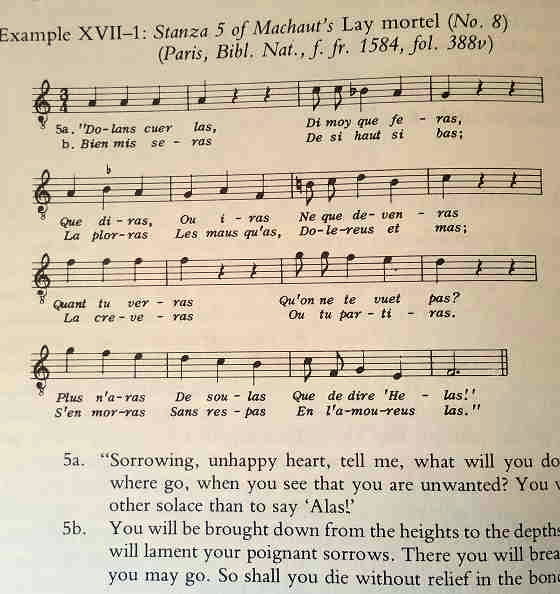 Also to be noted is the rhythmic identity of the melody's two halves�DMachaut often set lines or group of lines of equal length to the same rhythmic pattern and thus gave many stanzas a structure that is partially or completely isorhythmic. Yet he always managed to avoid monotony in these lengthy pieces �\and to match the rhythmic variety of their text �\by his skillful distribution of similar and contrasting rhythmic patterns within single stanzas and from stanza to stanza. ����ɒ��ڂ��ׂ��́A�����f�B�����̃��Y���I���ꐫ�ł���B�}�V���[�͂����A�s��s�̃O���[�v���A���������Y���p�^�[���ɑ��ē����������ɂ��A����䂦�A�����̃X�^���U�ɃC�\���Y���I�\����^�����B����ɔނ́A�P��̃X�^���U���ŁA���邢�̓X�^���U����X�^���U�܂ł̗ގ������ΏƓI�ȃ��Y���p�^�[���̍I�݂Ȕz���ɂ���āA��ɁA�����̒�����i�̒P����������悤�Ƃ��Ă����B p�S�O�U �@Changes of pitch level perform similar functions in organizing and contrasting successive stanzas, with the added peculiarity that lais often end on a higher pitch level than they began. All of Machaut's display use of the same melody for the first and last stanzas�A but in eleven lais that melody is transposed up a fifth when it returns in stanza 12. In one lai (No.6), the transposition is up a fourth, and in the polyphonic Lai 18 it is down a fourth (see p409�j. Only five lais in addition to the first begin and end at the same pitch level (Nos 2, 3, 8 12, and 17). The last two of these are polyphonic and are therefore unusual in other ways as well. �@lai���n�܂�������������ŏI�~����悤�ȓ������������A�����̕ω��́A�\�����A�A������X�^���U�̒��œ��l�̋@�\�������B Machaut�̂��ׂẮA�ŏ��ƍŌ�̃X�^���U�ɓ��������f�B���g�p���Ă��邪�A11��lais�ɂ����ẮA�����f�B�́A��P�Q�X�^���U�Ŗ߂鎞�ɂ́A5�x��ֈڒ�����Ă���B1��lai(No.6)�ł́A�ڒ��͎l�x��ł���A�|���t�H�j�[�ł���Lai 18�ɂ����ẮA�l�x���ƂȂ��Ă���B�ŏ��ɉ�������T��lais�݂̂́A���������Ŏn�܂�A�I����Ă���iNos 2, 3, 8 12, and 17)�B�����̂����̍Ō�̂Q�̓|���t�H�j�[�ł���A����䂦�A���܂��܂ȓ_�Œʏ�ł͂Ȃ��B Transposition of the final stanza is by no means the only contrast of pitch level in Machaut's lais. Even those that begin and end at the same level have internal stanzas at different levels and with different final notes. Typically, Machaut seems to have deliberately sought a new and different succession of pitch levels and final notes for each lai. Only in Lai 5 and in Lai 19 from the Remede de Fortune is that succession the same. Every other lai is unique in its arrangement of these contrasting elements�D �@�Ō�̃X�^���U�̈ڒ��́A�����āA�}�V���[��lais�̉����̗B��̃R���g���X�g�ł͂Ȃ��B���������Ŏn�܂�I�����̂ł����A�قȂ��������ƈقȂ����I�~���̓����̃X�^���U������B��ʓI�ɂ́A�}�V���[�͂��ꂼ���lai�̂��߂̉����ƏI�~���̐V�����A�قȂ����A�������߂Ă����悤�Ɏv����BRemede de Fortune�����Lai 5 and in Lai 19�ɂ����Ă̂݁A���������A���������ɂȂ��Ă���B���̑��̂��ꂼ���lai�́A���������ΏƓI�v�f�ɂ��Ă̔z��ɂ����ẮA�Ǝ���������B Different pitch levels within a lai and the transposition of the melody for its final stanza raise questions as to the manner of its performance�DSingle stanzas have a normal range of an octave or a ninth, but the changes of pitch level give the lais a total range that often or two notes short of two full octaves. Pieces with such a wide range and of such length are so exceptional, either in polyphony or in other forms of monophonic songs, that one wonders whether Machaut intended his lais to be sung only one performer. �@lai�̓����̈قȂ���������A�Ō�̃X�^���U�ɂ����郁���f�B�̈ڒ��́A���̉��t�l���ɂ��Ă̋^�₪�オ���Ă���B�ЂƂ̃X�^���U�́A�ʏ�I�N�^�[�u�Ȃ�����x�̉������������Ă��邪�A�����̕ω���2�I�N�^�[�u�߂��ɂ��Ȃ�B���������L������������i�́A��O�I�ł���A�|���t�H�j�[�����邢�̓��m�t�H�j�[��i�̕ʂ̌`���ɂȂ�B�}�V���[���A�ނ�lais���ЂƂ�̉̎�ɂ���ĉ̂��邱�Ƃ��Ӑ}���Ă������ǂ����͋^��ł���B Literary sources abound in references to lais played on instruments alone or sung to the accompaniment of a harp�D Perhaps it is not too fanciful to suggest that two performers spelled each other in singing a lai ,each taking the stanzas best suited to his voice while the other improvised a simple accompaniment in discant style. That two of Machaut's seemingly monophonic lai are in reality polyphonic increases the plausibility of this suggestion. It would at least make the lais easier for modern singers and more attractive for modern audiences. �����������ɂ����āA�y��݂̂ɂ���Ă��邢�̓n�[�v���t�ʼn��t���ꂽlai�ɂ��Ă̌��y�͑����B�ӂ���̉��t�҂��݂���lai���̂��Ȃ���X�y�������������A���肪�P���Ȕ��t���ł��Ă��鎞�ɃX�^���U�������̐��ɍ��킹���肷�邱�Ƃ��Ă���̂́A���ɋ�z�I�Ƃ����킯�ł͂Ȃ��B�P���Ǝv��ꂽ�}�V���[��lai�̂Q��i���A���ۂɂ̓|���t�H�j�[�ł��������Ƃ́A���̒�Ă̐^���������߂�B����͏��Ȃ��Ƃ��A����̉̎�ɂƂ��ẮAlais���̂��₷�����A����̒��O�ɂ͂�薣�͓I�ƂȂ邱�Ƃ��낤�B THE POLYPHONIC LAIS Four of Machaut's lais prove to be polyphonic, although their appearance in the manuscripts differs not at all from the monophonic pieces. It has long been recognized however, that Machaut called for canonic performance of Lai 11 and 12, which are found together in all manuscripts. In the first of these pieces, each even-numberd stanza is prefaced by the designation Chace and followed by the remark "a second time without pause" (iterum sine pausa). �ʖ{���ł̏o���́A�ꌩ���m�t�H�j�[��i�̂悤�Ɍ����邪�A�}�V���[��lais�̂����̂S�́A���̓|���t�H�j�[�ł��邱�Ƃ��ؖ�����Ă���B�����ԁA�}�V���[��Lai 11 �� 12�̃J�m���I���t�����߂Ă����Ƃ��m���Ă����B�����͂��ׂĂ̎ʖ{���Ɍ��o�����B�����̍�i�̍ŏ��ɂ����ẮA���ꂼ��̋����i���o�[�̃X�^���U�́AChace�̎w����Ă���A�u�Q��ڂ͋x�~�Ȃ��Łv (iterum sine pausa)�Ƃ������Ă���i�����j�B 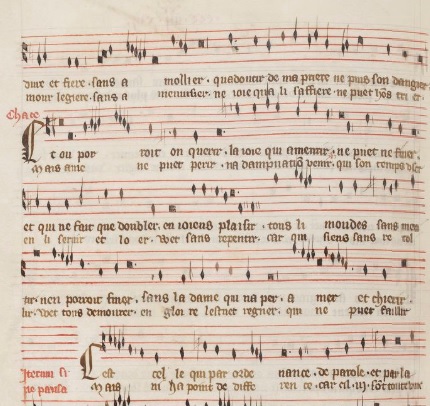 16. Je ne cesse de prier (Le Lay de la Fonteinne) http://gallica.bnf.fr/ark:/12148/btv1b84490444/f814.image As a result of the canons, which are assumed to be for three voices in the manner of the French chace (see Chapter XV), monophonic and polyphonic stanzas alternate throughout the lai. This procedure has another and more unexpected result: the single melody of stanza 1 becomes a voice canon when it returns transposed up a fifth in stanza 12. �t�����X��chace�i��15�͎Q�Ɓj�̂悤��3���ł���Ƒz�肳��Ă���J�m���̌��ʂƂ��āA���m�t�H�j�[�ƃ|���t�H�j�[�̃X�^���U��lai�S�̂ɂ킽���Č��݂Ɍ����B���������菇�́A�v��ʂ����ЂƂ̌��ʂ������炵���B��P�X�^���U�̃����f�B�́A���ꂪ��12�X�^���U�Ōܓx��Ɉڒ����ꂽ�J�m���ƂȂ�̂ł���B 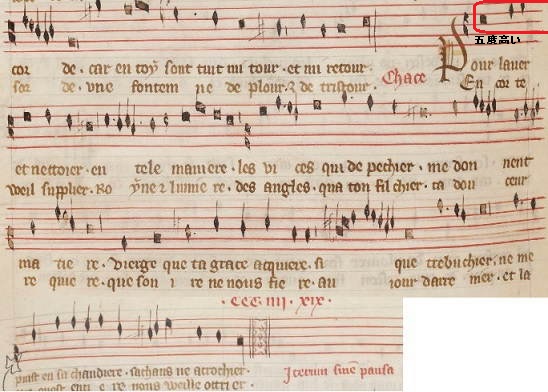 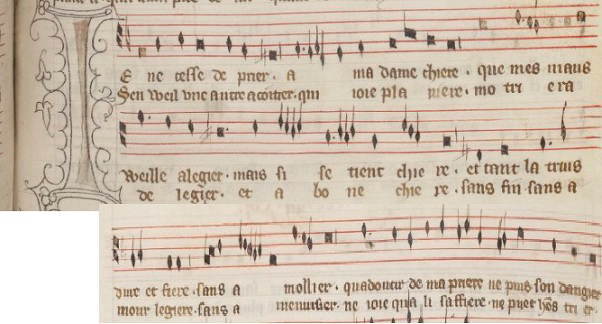 http://gallica.bnf.fr/ark:/12148/btv1b84490444/f813.image p�S�O�W None of the stanzas in Lai 12 is called a chace, but canonic performance is implied by a remark that the second half of the first stanza, like all the others, is to be sung at once and without pause. Unfortunately, the manuscripts give no hint as to the number of canonic voices or where they should enter, and in some stanzas at least, unusual and inexplicable dissonances suggest that the published transcriptions as three-voice canons may not have correctly realized Machaut's intentions. Lai 12�̂ǂ̃X�^���U���Achace�Ƃ͌Ă�Ȃ����A�J�m���I�ȉ��t�́A�ŏ��̃X�^���U��2�Ԗڂ��x�~�Ȃ��ʼn̂��邽�߂̈ӌ��ɂ���Ăق̂߂�����Ă���B�c�O�Ȃ���A�ʖ{�̓J�m�������̐���ǂ����炻��炪�����Ă���̂��ɂ��Ă͉���q���g��^���Ă���Ă��Ȃ��B���Ȃ��Ƃ��������̃X�^���U�ɂ����ẮA�ʏ�ł͂Ȃ��s���ȕs���a�����A�R���̃J�m���Ƃ��ďo�ł��ꂽtranscriptions�����m�Ƀ}�V���[�̈Ӑ}�𗝉����Ă��Ȃ����Ƃ������Ă���B The other two polyphonic lais, Nos. 17 and 18, appear in only one manuscript and are presumed to be Machaut's last compositions in the genre. The Lay de Consolation (No. 17) is unique in having different melodies for the two halves of each stanza. The first stanza (Example XVII-2) will suffice to illustrate the simple, almost note-against-note style that prevails throughout the lai when the two melodies for each stanza are combined in two-part polyphony. �@���̑��̂Q�̃|���t�H�j�[lai�ł���Nos. 17 and 18�́A�ЂƂ̎ʖ{�݂̂ł�������Ȃ����A���̕���ɂ�����}�V���[�̍Ō�̍�i�ƍl�����Ă���BLay de Consolation (No. 17(23))�́A���ꂼ��̃X�^���U��2�����̈قȂ��������f�B�����邱�Ƃɂ����ēƓ��ł���B�ŏ��̃X�^���U(Example XVII-2)�́A���ꂼ��̃X�^���U�̂Q�̃����f�B���Q�̃|���t�H�j�[�̑g�ݍ��킹�ƂȂ�ꍇ�́A�P���ȁA�قƂ�� note-against-note style�ł��邱�Ƃ�������Ă���B 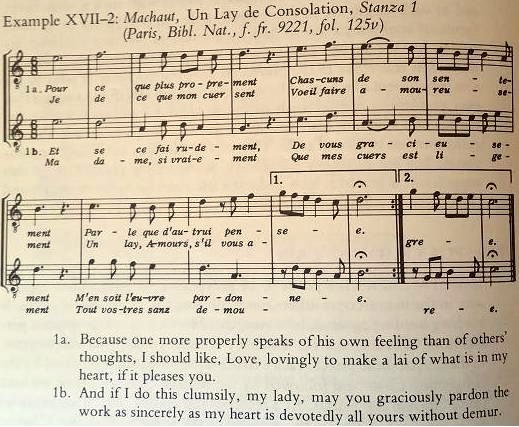 �G�j1a��b�͑�P�X�^���U���\������y�A�ł���A�ʏ�͓��������f�B���̂���̂����A���̋Ȃ����͕ʂ̃����f�B�ƂȂ��Ă���B�������������f�B�͈ꏏ�Ƀ|���t�H�j�[�Ƃ��ĉ̂��Ă��A�㕈�̂悤�ɁAnote-against-note style�Ōĉ�����悤�ɂł��Ă���B �ނ̓T�^�I��lai�́A�ȉ��̂悤�ȍ\���ł���B�P�Q�̐߂łł��Ă���A�ŏ��ƍŌ�́A���̍\���ł���A�������y�������Ă���B���ꂼ��̐߂�2�Z�N�V�����ɕ������A���������f�B���̂�ꂽ�B���ꂼ��̃Z�N�V�����͂���ɂQ�̃T�u�Z�N�V�����ɕ������A���҂̓����f�B�̓���������A�����ĉ̂����B�iMusic in the Middle Age p348�j Seven more stanzas including the last, end on a unison c', while four have closed endings on the fifth g-d' (stanzas 5 and 8-10). The effect is almost modern in its shift to the dominant and subsequent return to the tonic. �i���̑�P�Ɓj�ŏI���܂߂Ă���ɂV�̃X�^���U��c'�̃��j�]���ŏI�~���邪�A�c��S�̃X�^���U 5�A8-10�́Ag-d'�̌ܓx�ŏI�~����B���̌��ʂ́A�h�~�i���g�ւ̃V�t�g�ɂ����ċߑ�I�ł���A�����āA���������ăg�j�b�N�ɖ߂�B p�S�O�X �@Also published as a monophonie piece by Ludwig and Schrade, the "hidden polyphony" of Lai 18 is produced in still another way. Here, the melodies of the first three stanzas combine in three-part polyphony, a procedure which is repeated in groups of three through stanza 12�B Thus the melody of stanza 1 is combined with two different melodies when it returns, transposed down a fourth, in stanza 12. �@���l�� Ludwig��Schrade�ɂ���ă��m�t�H�j�[�Ƃ��ďo�ł���A��P�WLai���h�B���ꂽ�|���t�H�j�[�h�́A����ɕʂ̂����łł��Ă���B�����ł́A�ŏ��̂R�̃X�^���U�̃����f�B�͂R���|���t�H�j�[�Ƃ��đg�ݍ��킳��A���̎菇�͑�P�Q�X�^���U��ʂ��āA�R�̃O���[�v�ɂ����ČJ��Ԃ����B�䂦�ɁA��P�X�^���U�̃����f�B�́A���ꂪ��P�Q�X�^���U�ɂ����Ďl�x�Ⴍ�ڒ�����āA�Q�̈قȂ��������f�B�Ƒg�ݍ��킳�邱�ƂɂȂ�B The four polyphonic lais raise further questions as to the manner of performance. We need only note here that the required performing group might well include instrumentalists to play the accompanying polyphony while the melodies of the stanzas are sung in properorder. The resulting repetitions would take no longer than a normal monophonic lai. �@�S�̃|���t�H�j�[��lais�́A���t�`�Ԃɂ����Ă���Ȃ�^�₪����B��X�͈ȉ��̂悤�ɋL���݂̂ł���B�@�v�����ꂽ���t�O���[�v�͐�������|���t�H�j�[�����t���邽�߂Ɋy����܂߂Ă������Ƃł��낤�B�X�^���U�̃����f�B���ŗL�̏����ʼn̂��邽�߂ɁB���̌��ʂƂ��Ă̔����͂��͂�A�ʏ�̒P����lai�ȏ�̂��̂ł͂Ȃ��B If we assume that Machaut's polyphonic lais represent an effort to revitalize and modernize the form, we must admit that the effort was un successful. The lais themselves stand out as high points of Machaut's creative activity, but they inspired no successors. In the later fourteenth and fifteenth centuries, treatises on the art of poetry describe the form of the lai much as Machaut established it, and poets continued writing lais. �@�}�V���[�̃|���t�H�j�[�Ilai���A���̌`�����ĕ��������A�ߑ㉻����ƍl����̂ł���A����͊ԈႢ�ł���Ƃ����邾�낤�Blais���g�́A�}�V���[�̑n���I�����̍����|�C���g�������Ă��邪�A�|���t�H�j�[�Ilai�͂��̌p���҂Ƃ͌����Ȃ��B14���I�㔼����15���I�ɂ����āA���|�p�ɂ��Ă̘_���́A�}�V���[��lai�̌`�����m�������ƋL�q���Ă���A���l��lais�����������Ă����̂ł���B As far as we know, however, none of these later poems was ever set to music. The lai as a musical form was evidently the victim of changing times and tastes. Monophonic song was no longer palatable in largescale works, and poets who could write lais lacked the knowledge an technical skill to provide them with polyphonic settings. Composers, on the other hand, preferred the shorter lyric forms for their polyphonic songs. As specialists in music they were no longer capable of writing the text of a lai, and they may well have shrunk from the difficulty of providing one with an adequate musical setting. Few composers, certainly, could have matched the supreme with which Machaut accomplished this task. ��������X�Ɍ���A���������㔼�̎��̂��ׂĂ����y��ݒ肳��Ă���킯�ł͂Ȃ��B���y�`���Ƃ��Ă�Lai�́A���炩�ɁA����Ǝ���̕ω��̋]���҂ł����B�P���̂͂��͂��K�͍�i�Ƃ��ẮA����Ȃ��Ȃ��Ă��Ă���Alai���������l�����́A������|���t�H�j�[�ݒ�ɂ��邽�߂̋Z�p�������Ă����B�����ȉƂ����́A�|���t�H�j�[�̂��߂ɁA���Z������`�����D�B���y�̐��ƂƂ��āA�ނ�͂��͂�la�̃e�L�X�g�������\�͂͂Ȃ��A�K�x�ȉ��y�ݒ������������i�����̍������K���݂��Ă�����������Ȃ��B�قƂ�ǂ̍�ȉƂ����́A�}�V���[���������������̎d���̐������Ƀ}�b�`���邱�Ƃ��ł��Ȃ������̂ł���B COMPLAINTE AND CHANSON ROYAL http://machaut.exeter.ac.uk/?q=node/2058 Machaut's lyric poems include a number of complaintes and chansons royaux, but he provided music settings only for the one example of each type that he included in the Remede de Fortune. The primary interest of these monophonic songs lies in the evidence they provide, together with the older lais, of Machaut's links with the past. His Complainte bewails the trickery of both Fortune and Love in no fewer than thirty-six stanzas, all of which have the same sixteen-line form and are sung to the same melody. �}�V���[�̏���́A��������complaintes �� chansons royaux���܂�ł���B�������ނ́ARemede de Fortune�Ɋ܂܂ꂽ���ꂼ��̃^�C�v�ɂ킸���P�ȂÂ������y�ݒ�����Ă��Ȃ��B���������P���̂̏����I�S�́A����炪���Â�lai�ɏW�܂�A�}�V���[�̉ߋ��Ƃ̌��т��A�Ƃ����ϓ_�ɂ���B�ނ�Complainte�́A36�X�^���U�ȏ������A�^���ƈ��̍��\�ւ̒Q���ł���B���ׂĂ͂P�U�s�`���ł���A���������f�B�ʼn̂���B p410 Although the implication of the title Chanson royal is uncertain, its connection with the trouvere tradition is obvious. Indeed it proves to be a typical "solemn and majestic'' song in praise of love with five stanzas and an envoy. The melody of the chanson is also typical in its use of the aab form in which thirteenth-century trouveres cast most of their love songs. Conversion of this poetic and musical form into a ballade required only a reduction to three stanzas and the addition of a refrain. Chanson royal�̃^�C�g���̈Ӗ������͕s�m���ł͂��邪�A����ƃg�����F�[���̓`���Ƃ̊W�͖��炩�ł���B����́A�T�̃X�^���U�ƂP�̍ŏI�A�����A�����^�������T�^�I�ȁh�������s��h�ȉ̂ł���B���̃����f�B�͂܂��A13���I�̃g�����F�[���������ނ�̈��̉̂𓊂������� aab�`���ɂ����āA�����I�ł���B���̎��I���y�I�`���̃o���[�h�ւ̕ω��́A�R�̃X�^���U�����炵�A���t�����������邾���Ő�������B The melodic form of Machaut's Complainte a0acb0bc, also turn up, but as a less common structural pattern, in his and other composers's ballades. This fusion of chanson and ballade seems to have occurred early in the fourteenth century, at least as far as composers were concerned. The characteristic features of the ballade now prevailed, and the true chanson had almost ceased to exist as a separate musical form. Perhaps Machaut gave a sly hint that such songs were outdated when he allowed "the lover" to confess that he doze a bit during the lady's singing of the Chanson royal (un petitet m'i endormi" -line 1980). One wonders if the lady may not have slept even more soundly during lengthy Complainte. Machaut��Complainte�̃����f�B�`����a0acb0bc�ł��邪�A�ނ́A���邢�͂��̑��̍�ȉƂ̃o���[�h�ɂ����āA����ʓI�ł͂Ȃ��\���p�^�[���Ƃ��ďo������B���������V�����\���ƃo���[�h�Ƃ̗Z���́A14���I�����ɋN�������ƍl�����邪�A���Ȃ��Ƃ���ȉƂ����͊S�������Ă������Ƃ��낤�B�o���[�h�̓����͂��łɒm���Ă���A�^�̃V�����\���͉��y�`���Ƃ��ĕ������ꂽ���݂ł��邱�Ƃ���߂Ă����B�����炭�}�V���[�́A �h���l�h�ɑ���Chanson royal �̏����̉̂̊ԁA������Ƃ������������������ɁA���������̂�����x��ɂȂ������Ƃւ̂�����Ƃ����q���g��^���Ă����̂ł��낤�B���������̂悤�Ȓ��� Complainte�̊Ԃɖ����Ă��܂�Ȃ��Ǝv��������Ȃ̂ł͂Ȃ����B THE MOTETS http://machaut.exeter.ac.uk/?q=node/1546 Like the lais that precede them in the manuscripts, Machaut's twenty-three motets are often said to represent the more conservative aspects of his musical output. This judgment can be accepted only with reservations. By the time of Machaut, the motet had existed as a musical form for more than a hundred years, and its traditional and identifying characteristics were well established. �ʖ{���ɐ旧��lais�̂悤�ɁA�}�V���[�̂Q�R�̃��e�b�g�͂����A�ނ̍�i�ɂ����ẮA���ّf�G�ȑ��݂ł���A�Ƃ������Ƃ������Ă���B�����������f�́A�c���ꂽ��i��ʂ��Ă݂̂Ȃ���Ă���B�}�V���[�̎���܂łɁA���e�b�g�͉��y�`���Ƃ��Ă��ł�100�N�ȏオ�o���Ă����B�����Ă��̓`���I�A����̐����͊m�����Ă����B Neither Machaut nor any other fourteenth-century composer would have considered abandoning the structural and stylistic elements then regarded as appropriate for the motet. To say that this was being conservative as opposed to the "progressive" treatment of polyphonic secular songs is to overlook the essential differences between the two musical types. It is a measure of Machaut's greatness as a composer that he could adopt different musical styles and even different compositional techniques while remaining unmistakably a child of the French Ars Nova. �}�V���[���邢�͂��̑���14���I�̍�ȉƂ́A���e�b�g�ɑ���K���ȊS����悤�ȍ\���I�l���I�v�f�����łɎ̂ċ����Ă����ƍl������B�������āA�|���t�H�j�[�I�������́h�i���I�h��舵���ɑR���Ă��ꂪ�ێ�I�ł���Ƃ������Ƃ́A�i�����ێ牻�Ƃ����Q�̉��y�`���̖{���I�Ⴂ���������Ă��܂����ƂɂȂ�B p�S�P�P The one respect in which Machaut does seem to look backward in his motets is his striking preference for French secular texts. Only six of the twenty-three pieces are Latin motets, and two more have a Latin duplum and French triplum. Of the fifteen entirely French motets, three even have secular French tenors. All other tenors have Latin incipits that suggest plainchant origins, although the specific sources of melodies have yet to be discovered. Although much of the contemporary motet literature may have been lost, it seems probable that Machaut's concentration on French secular texts reflects his own preference rather than the common practice of his time. �@�}�V���[���ނ̃��e�b�g��x�ꂽ���̂̂悤�Ɍ��Ă��邱�Ƃɂ��ẮA�t�����X��̐����e�L�X�g�ɑ���ނ̒����Țn�D���W���Ă���B�Q�R��i�̂����킸���U�����e���ꃂ�e�b�g�ł���A����ɂQ�̓��e�����duplum�ƃt�����X���triplum�������Ă���B�P�T�̑S�̓I�ȃt�����X�ꃂ�e�b�g�̂����A�R�͐����̃t�����X��̃e�m�[���������Ă���B���̑��̂��ׂẴe�m�[���̓��e����Ŏn�܂�A���ꂠ�v���C���\���O�̋N���ł��邱�Ƃ��������Ă���B�����f�B�̓���Ȏ����͂��łɌ������Ă͂��邪�B�����̓�����̃��e�b�g�͎���ꂽ��������Ȃ����A�}�V���[�̃t�����X�ꐢ���e�L�X�g�ւ̏W���́A�����̎���w�i�����A�ގ��g�̚n�D�f���Ă���B Latin motets far outnumber French in the Romande Fauvel, and they account for more than half of the motet repertory in the Ivrea Codex (see Chapter xv). Later collections usually contain a few French motets with texts that sing the praises of an unnamed lady who sometimes turns out to be the Virgin Mary. More and more, however, the motet dissociates itself from secular song in the vernacular. Romande Fauvel�ɂ����ẮA���e���ꃂ�e�b�g�̓t�����X��i�̂���j�����͂邩�ɑ����B�����Ă����́A�C�����A�ʖ{���̃��e�b�g�̃��p�[�g���[�̔����ȏ���߂Ă���B����̎ʖ{�͒ʏ�A�����}���A�ł��邱�Ƃ��������閼���Ȃ������̎^�����̂��e�L�X�g���������Ȃ��t�����X�ꃂ�e�b�g���܂�ł���B�������܂��܂��A���e�b�g�͐����̂���vernacular�ւƕ������Ă����B Its Latin texts tend to have some liturgical, or at least religious, connection or to celebrate important persons or historical events. Machaut himself foreshadowed this trend in his most elaborate and presumably latest motets (Nos. 21-23). It may well be, indeed, that Machaut's contributions to the development of a polyphonic style more appropriate for secular song led him and those who came after him to turn away from the French motet and to adopt the newer and more popular forms of the ballade rondeau, and virelai. ���e����e�L�X�g�͓T��I�A�@���I�ȌX���������A�d�v�l������j�I�o�������j���邽�߂Ɏg���Ă���B�B�}�V���[�͂��������X����ނ̂����Ƃ����k�������炭�ŐV�̃��e�b�g(Nos. 21-23)�ŗ\�������B�������}�V���[�̃|���t�H�j�[�l���̔��W�ւ̍v���́A�ނ������ɓ����������̂ɂ����Ă��K���ł���A�ނ̌�̎Q���҂́A�t�����X�ꃂ�e�b�g����Q�����A���V�����l�C�̂���`�����̗p�����B���ꂪ�A�o���[�h�A�����h�[�A���B�����[�ł���B If Machaut's motets may be conservative and even backward-looking in their use of French texts, the same cannot be said of their musical style. Without exception, they follow fourteenth-century notational procedures and use the different combinations of mensurations described by Philippe de Vitry and Johannes de Muris. They also follow and develop the structural procedures established by the "modern�h motets in the Roman de Fauvel and the works of Vitry. �@�}�V���[�̃��e�b�g���ێ�I�ł���A�t�����X����g���_�ɂ����Ēx��Ă���悤�Ɍ�����悤�ł���A�������Ƃ͂��̉��y�l���ɂ������邱�Ƃł���B��O�Ȃ��A������14���I�̋L���@�ɏ]���APhilippe de Vitry��Johannes de Muris�ɂ���ċL�q���ꂽ�L�q�@�̈قȂ����g�ݍ��킹���g�p���Ă���B������Roman de Fauvel�⃔�B�g���ɂ�����h�ߑ�I�h�ȃ��e�b�g�ɂ���Ċm�����ꂽ�\���ߒ��ɏ]���A�܂����W�������B Nineteen of Machaut's motets have the typical three-voice arrangement of a duplum and triplum with different texts above a tenor. The remaining four (Nos. 5 and 21-23) add a textless contratenor to this arrangement. Except for one motet with a rondeau tenor, all of these pieces display the contrasts of mensural organization that we noted in the works of Vitry and that remain characteristic of the isorhythmic motet throughout its subsequent history. Tenors and contratenors when present, normally move in the longer note values of mood and time, while the upper voices use one of the possible combinations of time and prolation. �@�}�V���[�̃��e�b�g�̂����̂P�X��i�́A�e�m�[����ɈقȂ����e�L�X�g�ł���duplum��triplum���������T�^�I�ȂR���ł���B�c��̂S��i(Nos. 5 and 21-23)�́A�A�����W�ɂ���āA�e�L�X�g�̂Ȃ��R���g���e�m�[����������Ă���B�����h�[�e�m�[�������ЂƂ̃��e�b�g�������āA�����̍�i���ׂẮA�v�ʋL���@�ł���A����̓��B�g���̍�i�ɂ���A����ȍ~�̗��j�ɒʂ���C�\���Y�����e�b�g�̓������c���Ă���B�e�m�[���ƃR���g���e�m�[���́A�ʏ�A��蒷�������œ����A���̊ԁA�㐺���̓e���v�X�A�v�����c�B�I�̑g�ݍ��킹�œ����Ă���B We find all four of these combinations in Machaut's motets, but imperfect time with major prolation (6/8) occurs in fifteen of the pieces. This predominance of 6/8 mensuration was so characteristic of French polyphony in the fourteenth century that contemporary Italians applied the adjective gallica to the corresponding mensuration in their own notation (see Chapter18). ��X�́A�}�V���[�̃��e�b�g�̂����ł̂��������g�ݍ��킹���S���o���B�������A�s���S�e���v�X���S�v�����c�B�I�i6/8�ɑ�������j�́A��i�Q���̂P�T��i�Ɍ��o�����B��������6/8�v�ʖ@�̗D�ʂ�,14���I�̃t�����X��|���t�H�j�[�̓����ł���B�������̃C�^���A�́A�ނ玩�g�̌v�ʋL���@(see Chapter18)��gallica�i�t�����X���j�Ƃ����`�e���Ă͂߂Ă����B Just as 6/8 predominates in the upper voices of Machaut's motets, so is perfect mood by far the most common mensuration of their tenors. It too occurs in fifteen pieces, with only four in imperfect mood. In three of the four-voice motets, the tenor and contratenor combine perfect and imperfect mood in various ways �}�V���[�̃��e�b�g�̏㐺���ɂ�����6/8�̗D�ʐ��Ƃ��āA�����̃e�m�[���̂����Ƃ����ʂ̌v�ʋL���@�͊��Smood������B�����15��i���Ɍ����A�S�݂̂��s���Smood�ł���B�S�����e�b�g�̂����̂R�ɂ����āA�e�m�[���ƃR���g���e�m�[���͂��܂��܂Ȃ����ɂ����āA���S�ƕs���Smood��g�ݍ��킹�Ă���B MACHAUT'S ISORHYTHMIC STRUCTURES http://machaut.exeter.ac.uk/?q=node/1546 All of Machaut's motets are isorhythmic with the exception of the three that use secular French tenors, and even these reveal the influence of isorhythmic techniques.Any analysis of those techniques must consider techniques both the structure of the lower voice or voices and the relation of that structure to the appearance of isorhtymic passages in in the upper voices.Machaut's closest approach to the use of strict isorhythm in all voices occurs in Motet 4, but every motet has some repeated patterns in the duplum and triplum that clarify the structure of the tenor or create structure that the tenor by itself leaves undefined. �}�V���[���e�b�g�̂��ׂẮA�����t�����X���p�����R�������āA�C�\���Y���ł���B�������܂��A�C�\���Y���̃e�N�j�b�N�̉e�����Ă���B���������e�N�j�b�N�̕��͂́A�ᐺ���̍\���ƃC�\���Y����̏o������\���̗��҂̃e�N�j�b�N���l�����Ȃ���Ȃ�Ȃ��B�}�V���[�̌����ȃC�\���Y���̎g�p�ւ̍Őڋ߂́A��S���e�b�g�Ō����邪�A���ꂼ��̃��e�b�g�́A�e�m�[���̍\���𖾂炩�ɂ��A�e�m�[��������`�̂܂c���ꂽ�\����n������duplum �� triplum�ɂ����锽���p�^�[���������Ă���B For the most part, isorhythmic passages in the upper voices introduce hocket or some other device, such as syncopation or rhythmic sequences, that will stand out against the normal rhythmic and melodic flow of the motet as a whole. Such passages are often framed by conspicuous cadences�\long notes and full-measure rests�\that also recur in the same place above each succeeding talea in the tenor. This use of isorhythm in the upper voices, of course, makes the structure of motet more perceptible to the ear, which was undoubtedly the reason for its introduction. �啔���A�㐺���̃C�\���Y����́A�z�P�b�g�₻�̑��̍H�v�A�V���R�y�[�V������Y���I�A���Ȃǂ�����B����́A�T���āA���e�b�g�̒ʏ�̃��Y������f�B�̗���ɑR���悤�Ƃ��Ă���B����������͂����A�₩�ȃJ�f���c�\����������full-measure rests�\ �ɂ���Ęg�g�݂������B���������J�f���c�̓e�m�[���̘A���������ꂼ��̃^���A�Ɠ����ꏊ�ɋN����B���_�A���������㐺���ɂ�����C�\�C�Y���̎g�p�́A���̓����̗��R�͕s�m���ł��邪�A���e�b�g�̍\������莨�ɂ킩��₷������B �@In devising his isorhythmic tenors. Machaut invented new procedure, devising but he applied the old ones with astonishing variety and ingenuity. Moreover, he seems to have preferred devices that rarely appeared in the motets of Philippe de Vitry and the Roma de Fauvel. Exactly half of Machaut's isorhythmic motets, for example, close with a repetition of the tenor color and taleae in strict diminution. �@�C�\�C�Y���̃e�m�[�����l����ɂ�����A�}�V���[�́A�V�����菇���H�v�������A�Â����̂������ׂ��ω��ƓƑn���ł����āA�K�p�����B����ɁA�ނ́APhilippe de Vitry �̃��e�b�g�� Roma de Fauvel�ɂ͂߂����Ɍ���Ȃ��悤�ȍH�v���D�悤�Ɍ�����B�}�V���[�̃C�\���Y���I���e�b�g�̂��傤�ǔ����́A���Ƃ��A�����ȏk���ɂ�����e�m�[���̃R�����ƃ^���A�̌J��Ԃ��ŏI�~����B Another device that appears with increasing frequency in Machaut's motets is the use of a color that does not divide into a whole number of taleae. In several tenors, a color one and one-half times as long as the talea creates a structure that may be expressed by the formula 2C =3T. The complete formula may be repeated in diminution- as it is in Motets 4 and 7-or it may be repeated unchanged. Three statements of the formula in Motet 9, for example, give an overall form of 6C= 9T. �}�V���[�̃��e�b�g�ɂ����鑝�傷��p�x�ƂƂ��ɏo����������ЂƂ̍H�v�́A����̑S�̐��Ƃ͊����Ȃ��R�����̎g�p�ł���B�������̃e�m�[���ł́A�R�����̓^���A�̂P�D�T�{�ƂȂ�B���̂��߁A2C =3T�Ƃ����莮�ŕ\������邱�Ƃ��낤�B���S�Ȓ莮�͏k�����Ȃ���\Motets 4 and 7�ɂ���悤�Ɂ\�J��Ԃ����B���邢�́A�ύX����邱�ƂȂ��J��Ԃ����B���Ƃ��AMotet 9�ɂ�����莮�̂R��statements�͏�� 6C= 9T�̌`���ƂȂ�B In some motets, the repeated rhythmic patterns of the tenors are so short and simple that they seem to differ scarcely at all from thirteenth century practices. By introducing isorhythmic passages in the upper voices,however, Machaut groups two or more statements of a simple pattern into a longer talea and thus creates musical forms of considerable subtlety and sophistication. One of the most striking examples of this procedure occurs Motet 8, Qui es promesses (AMM, No. 61). �������̃��e�b�g�ɂ����ẮA�e�m�[���̔������Y���p�^�[���́A13���I�̎��H����قƂ�Ǖς��Ȃ��悤�ȒZ���A�V���v���Ȃ��̂ł���B�������A�㐺���̃C�\���Y���̋�����邱�ƂŁA�}�V���[�́A�Z���p�^�[���̂Q�`�R��statements���A��蒷���^���A�ɕ��ނ����B�����āA���ꂤ���ɁA���Ȃ萸���Ő������ꂽ���y�`����n�������B���̑�\��� Motet 8, Qui es promesses�\Ha! Fortune�\Et non est (AMM, No. 61)�ł���B In the manuscript sources, the tenor of this motet is written out once with a sign indicating threefold performance, and its division into four statements of a short rhythmic pattern also suggests a simple and somewhat primitive isorhythmic form (Example17-3a). The upper voices decide otherwise, however. By treating three of the rhythmic patterns as one talea, they make the form of the tenor become 3C=4T (Example 3b). �ʖ{�̎����̒��ŁA���̃��e�b�g�̃e�m�[���́A3�x��performance������������Ă���B�����ĒZ�����Y���p�^�[���̂S��statements�ւ̕����́A�P���ł����Ԃ��I�ȃC�\���Y���`���ł���(Example17-3a)�B�������A�㐺���͕ʂ̕��@�Ō��߂���B�ЂƂ̃^���A�Ƃ��Ẵ��Y���p�^�[�����R���舵�����Ƃɂ��A����̓e�m�[���̌`����3C=4T (Example 3b)�Ƃ����悤�ɂ���B 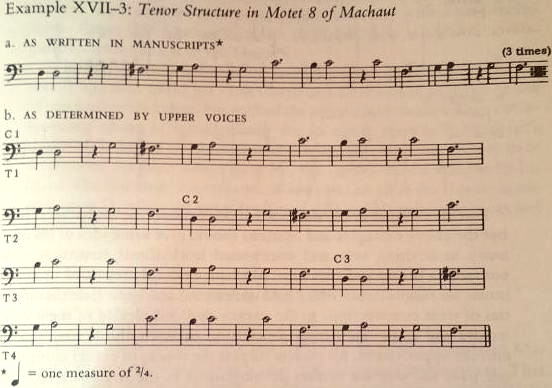 p413 The resulting taleae consist of twenty- seven measures, of which the last twelve are rhythmically identical each time. In this case, the isorhythmic passages in the upper voices introduce syncopation rather than hocket and close with an obvious cadence on the final tenor note of each talea. It should also be remarked that the triplum always uses the same rhythmic and melodic figure to lead into the next statement of the tale . In some of Machaut's motets, even larger amounts of melodic repetition increase the perceptibility of his isorhythmic structure. 27���߂���Ȃ�^���A�́A�Ō��12���߂̓��Y���I�ɂ��ꂼ�ꓯ��ł���B���̏ꍇ�A�㐺���ɂ�����C�\���Y���̋�́A�z�P�b�g�₻�ꂼ��̃^���A�̍ŏI�����ɖ��炩�ȃJ�f���c���I�~�����A�V���R�y�[�V���������Ă���Btriplum������statement�֓������߂ɏ�ɓ������Y���ƃ��Y���`�Ԃ��g���Ă��邱�Ƃ����ڂ��ׂ��ł���B�}�V���[�̃��e�b�g�̂������́A��K�͂ȃ����f�B�������A�C�\���Y���\���̒m�o�������Ă���B Another aspect of Machaut's motets that deserves detailed study is the internal symmetry and balance of the taleae themselves.One of his common procedures was to divide the talea into equal halves with identical or related rhythmic patterns. In two of the four motets with an added contratenor (Nos. 5 and 23), Machaut applied this procedure to the combination of the two lower voices rather than to the tenor alone. The tenor and contratenor use black and red notes in each of these pieces to produce passages of perfect mood in one voice against imperfect mood in the other. In Motet 23, these passages alternate in rhythmic, but not melodic, voice exchange, so that the combination of the two parts creates a talea with rhythmically identical halves (Example XVIl 4a). Motet 5 refines on this procedure by presenting the ex- changed rhythms in reverse or retrograde order (Example XVII-4b). The result of these combined rhythmic palindromes,the same when read backward or forward, is a talea with symmetrical rather than identical halves. (The oldest verbal obviously, is Adam's self introduction to Eve "Madam I'm Adam"). �@�ڍׂȌ����̉��l�̂���}�V���[�̃��e�b�g�̂����ЂƂ̑��ʂ́A���̓����̑Ώ̐��ƃ^���A���g�̃o�����X�ł���B�ނ̋��ʂ̎菇�̂ЂƂ́A�^���A���A���ꂠ�邢�͊֘A�������Y���p�^�[���œ����ɕ����邱�Ƃł������B�S�̃��e�b�g�̂����̂Q�� (Nos. 5 and 23)�ł́A�}�V���[�͂��̎菇���A�e�m�[�������ނ���A�Q�̒ᐺ���̑g�ݍ��킹�ɓK�p�����B�e�m�[���ƃR���g���e�m�[���͍��ƐԂ̉������g���A�Е������Smood�������Е����s���Smood���Y�����Ă���BMotet 23�ɂ����ẮA����������̓��Y���͕ω����邪�����f�B�͕ς�炸�A�����������s���A���̂��߂ɂQ���̑g�ݍ��킹�́A���Y���I�ɓ��ꔼ���̃^���A���Ă���(Example XVIl 4a)�BMotet 5�́A���Y���̌������A�t�]�Ƌt�s�ɂ���āA���̉ߒ�������ɐ������Ă���(Example XVII-4b)�B�����������Y���̉̑g�ݍ��킹�̌��ʂ́A�^���A�ꓙ���Ƃ������́A�Ώ̓I�ɂ��Ă���i�̂����Ƃ��ӂ邢���Ƃ킴�́AAdam��Eve�ɑ��鎩�ȏЉ�A�u"Madam I'm Adam"�v�ł���j�B 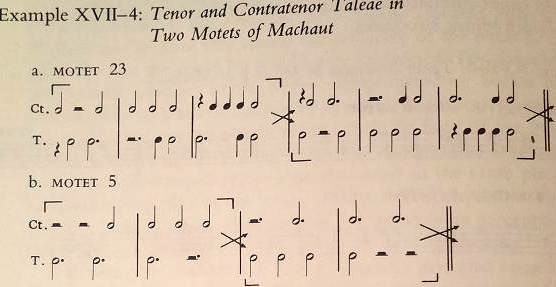
Further discussion of Machaut's motets cannot be undertaken here, but the above examples and citations should give some idea of his ingenuity in devising new and unexpected isorhythmic structures. Like composers before and after him, Machaut evidently regarded motets as music for connoisseurs who could understand and appreciate the subtleties of their construction. In the variety and complexity of their architecture and in the increasing penetration of isorhythmic organization into the upper voices, his motets surpass the works of earlier composers and pave the way for further developments in the late fourteenth and early fifteenth centuries. �@�}�V���[�̃��e�b�g�ɂ��Ă̂���Ȃ�c�_�͂����ł͏q�ׂȂ����A��L�̗����p�́A�V�����A�\�z�O�̃C�\���Y���I�\���ɂ��Ă̔ނ̗L�\���������Ă���B�ނ̑O��̍�ȉƂ̂悤�ɁA�}�V���[�͖��炩�ɁA���e�b�g�����y�̌��l(���̍����̏ڍׂ𗝉����]�����Ă����j�Ƃ݂Ȃ��Ă����B����������i�̕ω��╡�G���ɂ����āA�����āA�㐺���ւ̃C�\�C�Y���\���̐Z���̑����ɂ����āA�ނ̃��e�b�g�͏����̍�ȉƂ̍�i�𗽂��ł���A14���I�㔼~15���I�̔��W�̂��߂̃��[����~�����̂ł���B |